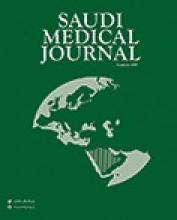Abstract
OBJECTIVES: To determine the trends in body fatness and obesity among Saudi primary schoolboys using the data from 2 cross-sectional studies conducted in 1988 and 2005.
METHODS: Two sets of data were analyzed. The first set (n=1082) was conducted in 1988 and the second (n=702) set was conducted in 2005. Both studies used multistage random samples involving primary-school boys aged 6-14 years from Riyadh, Kingdom of Saudi Arabia. Measurements included weight (Wt), height (Ht), biacromial (BA) and bi-iliac (BI) widths, triceps (T), subscapular (S) skinfolds, S/T ratio, body mass index (BMI), body fat percentage (fat%), lean body mass (LBM), and the proportion of obese boys (fat% > or =25% of Wt).
RESULTS: From 1988-2005 there were significant increases in all variables except LBM. The lowest changes were observed in body structures (Ht, BA, and BI) and the highest were in body fatness (T, S, and fat%). During this 17-year period, the mean BMI standard deviation increased from 16.5 ± 2.1 to 18.0 ± 4.0 kg/m2 and fat percentage increased from 13.2 ± 4.7 to 19.7 ± 10.0%. In addition, S/T ratio increased by 13.5%, indicating shifts toward central obesity over time. However, the biggest increase was seen in the proportion of obese schoolboys (from 3.4% in 1988 to 24.5% in 2005).
CONCLUSIONS: Findings indicate rising trends in BMI, body fatness, central obesity, and prevalence of obesity among Saudi schoolboys over the last 2 decades. Increased obesity prevalence among Saudi children is a major public health concern.
- Copyright: © Saudi Medical Journal
This is an open-access article distributed under the terms of the Creative Commons Attribution-Noncommercial-Share Alike 3.0 Unported, which permits unrestricted use, distribution, and reproduction in any medium, provided the original work is properly cited.






